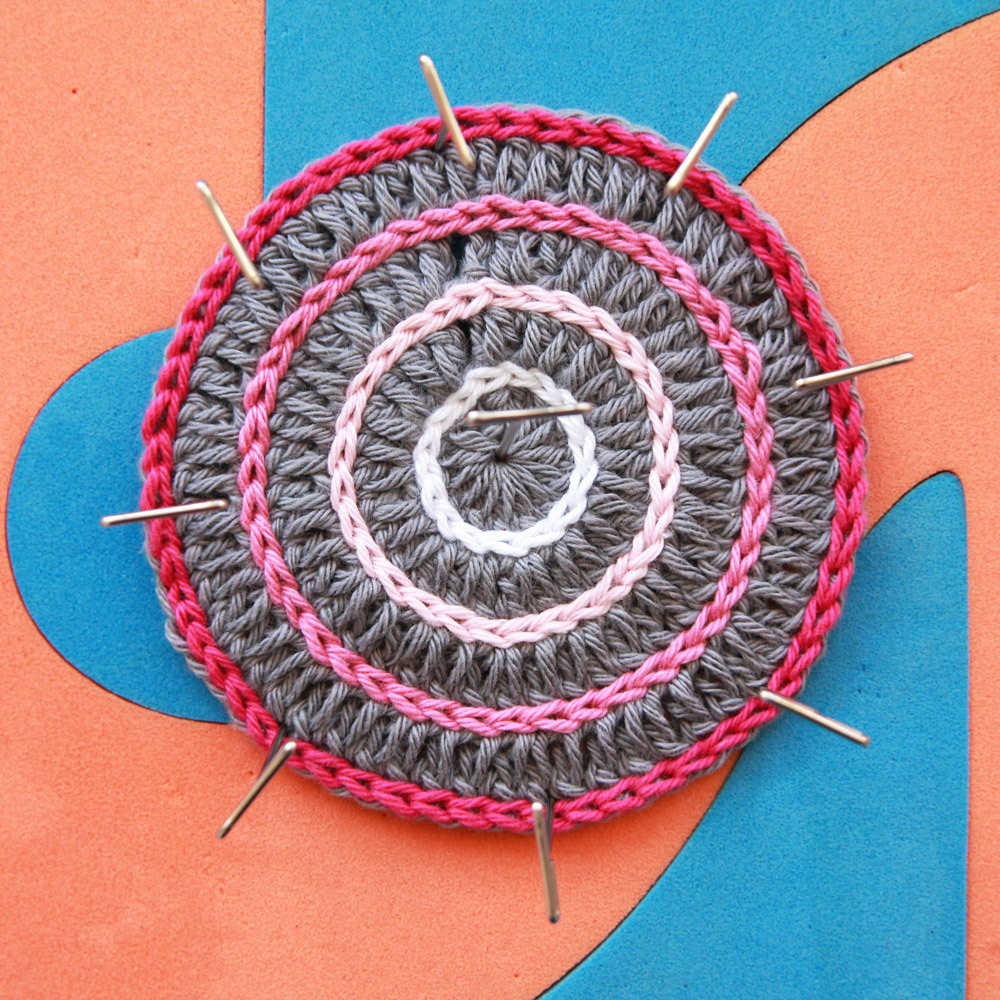Related articles:

Steam blocking
Steam blocking is the third and most notorious method of all blocking methods (see related articles). I say notorious because there are quite a few things you need to consider when using this blocking method.
First of all, it’s aggressive. Steam is hot and will treat your yarn harshly. So don’t use this method for delicate yarns such as Silk. However, if you have stubborn fibres such as cotton and acrylic, this method might benefit your work.
Secondly, you have to be careful with your steam iron. If you use any of those colour-covered headpins, and you touch them with your steam iron, they will melt, with a bit of bad luck, onto your piece. It’s not pretty and is impossible to remove.
Thirdly, steam blocking is usually not recommended for acrylic, as acrylic fibres can melt. The fact that they melt can be used to your advantage, though, a process known as ‘killing’ your fibre by melting small parts of the fibre. However, it’s irreversible and therefore pretty tricky to get right, considering you only have one shot.
Generally speaking, you can safely use this method for cotton fibres. Cotton is a pretty durable fibre, and I use this method to make my potholders nice and flat. The same goes for pieces that crease a lot, such as cotton placemats. Just be very gentle with your steam settings.
Materials needed
Necessary:
 | Blocking mats. The sturdy mats will help you pin down your work. (available on Wool Warehouse (UK) or Amazon). |
 | T-pins. I prefer T-pins over regular pins. They’re sturdier and easier to place. Whatever you choose, make sure they’re made out of stainless steel (available on Jimmy Beans Wool (US) or Wool Warehouse (UK) ). |
 | Eucalan, a leave-in yarn detergent. Technically not necessary, but I heavily recommend using it (available on Wool Warehouse (UK) and Jimmy Beans Wool (US) ). |
You will also need a steam iron and ironing mat.
Nice to have:
 | Blocking wires. These will help you block larger items such as shawls and blankets. (available Wool Warehouse (UK) or Jimmy Beans Wool (US)). |
 | Rainbow Blockers. These will speed up your blocking process by placing multiple pins at one go (available at Wool Warehouse (UK) or Jimmy Beans Wool (US)). |
Steam Blocking tutorial
Step 1: Pin
Pin your item into shape on your ironing board or blocking mats. If you have picots or shells in your pattern, pay extra attention to them to really open up the pattern. You may stretch your piece a little, but make sure not to form any peaks by overstretching your yarn.

Step 2: Hover and steam
Set your steam iron to its continuous steam output and hover over your piece, making sure not to touch the pins. Always keep a distance between your piece and the iron, around 3-5 cm or hover above the pins. If you can’t reach certain spots, lift your iron a bit higher and give it a small steam burst.
Hover over it for 30 seconds or so, and carefully feel your work. It should be hot, but not scorching hot (if so, you’re too close!). If it feels like it’s not resisting the pinned shape anymore (for example, the above example first really wanted to go back to its concave shape but after blocking it was perfectly flat) you’re done. If not, block for another 30 seconds. After that, it should be done. If not, it’s probably never going to be in the shape you pinned it. Put your iron away.
Please don’t touch the pins right away; they’ll be pretty hot. Something that goes for acrylic only: you will notice when you’re coming too close to your acrylic, because you can see it ‘wilting’ away a little bit (melting). If this happens, immediately stop.
Step 3: Cool
Leave your item to cool off for around 30 minutes. Afterwards, unpin.
(The pattern used in this example is the Roller coaster).




Comments
I fell in love with the Rainbow Sampler Stitch blanket from the moment I saw it! I have been crocheting 50 years (since learning at the age of 8!) and this was challenging, fun and beautiful! I live in Florida, so due to our weather, and to be honest, the availability of yarn during COVID, I used a #3 or sport weight yarn for the blanket, using Mandala yarn cakes separated into colors and then using my own colorways with your design as a guide. I plan to gift the blanket, which I made a bit smaller in width, to my Mother-in -law of over 30 years as a Mothers Day present.
I have blocked smaller objects before, especially lace doilies and small decorative items like bells, baskets and snowflakes that I then starched into shape. I have a professional clothing steamer, which I am planning to use to block the blanket. What do you think? The steam is very hot, but the design of the steamer allows for steam without using an iron and the possibility of touching the iron to the acrylic and melting it. How do you feel about this?
I really love your work! I love to learn new things and you are so very talented. Thank you for sharing the pattern in such an easy format. You are very generous with your extraordinary gifts, and I want you to know how truly appreciative I am. Thank you again for sharing!
All the best to you!
If you like, I would be glad to send you a photo of my blanket when completed. April 06, 2021 21:54 - Reply